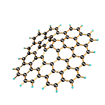Monday, December 22nd 2008
Researchers at the Rice University Create New Memory from Graphene
A team at Rice University has determined that a strip of graphite only 10 atoms thick can serve as the basic element in a new type of memory, making massive amounts of storage available for computers, handheld media players, cell phones and cameras. In new research available online in Nature Materials, Rice professor James Tour and postdoctoral researchers Yubao Li and Alexander Sinitskii describe a solid-state device that takes advantage of the conducting properties of graphene. Tour said such a device would have many advantages over today's state-of-the-art flash memory and other new technologies. Graphene memory would increase the amount of storage in a two-dimensional array by a factor of five, he said, as individual bits could be made smaller than 10 nanometers, compared to the 45-nanometer circuitry in today's flash memory chips. The new switches can be controlled by two terminals instead of three, as in current chips.Two-terminal capability makes three-dimensional memory practical as graphene arrays can be stacked, multiplying a chip's capacity with every layer, said Tour, Rice's Chao Professor of Chemistry as well as a professor of mechanical engineering and materials science and of computer science.
Being essentially a mechanical device, such chips will consume virtually no power while keeping data intact - much the same way today's e-book readers keep the image of a page visible even when the power is off.
What distinguishes graphene from other next-generation memories is the on-off power ratio - the amount of juice a circuit holds when it's on, as opposed to off. "It's huge - a million-to-one," said Tour. "Phase change memory, the other thing the industry is considering, runs at 10-to-1. That means the 'off' state holds, say, one-tenth the amount of electrical current than the 'on' state."
Current tends to leak from an "off" that's holding a charge. "That means in a 10-by-10 grid, 10 'offs' would leak enough to look like they were 'on.' With our method, it would take a million 'offs' in a line to look like 'on,''' he said. "So this is big. It allows us to make a much larger array."
While generating little heat itself, graphene memory seems impervious to a wide temperature range, having been tested from minus 75 to more than 200 degrees Celsius with no discernable effect, Tour said. That allows graphene memory to work in close proximity to hot processors. Better still, tests show it to be impervious to radiation, making it suitable for extreme environments.
Tour said the new switches are faster than his lab's current testing systems can measure. And they're robust. "We've tested it in the lab 20,000 times with no degradation," said Tour. "Its lifetime is going to be huge, much better than flash memory."
Best of all, the raw material is far from exotic. Graphene is a form of carbon. In a clump it's called graphite, which you spread on paper every time you use a pencil.
The technology has drawn serious interest from industry, said Tour, who's working on manufacturing techniques. He said it's possible to deposit a layer of graphene on silicon or another substrate by chemical vapor deposition. "Typically, graphene is very hard to think about fabricating commercially," he said, "but this can be done very easily by deposition. The same types of processes used right now can be used to grow this type of graphene in place."
The paper is available at www.nature.com/nmat/journal/vaop/ncurrent/abs/nmat2331.html
Source:
Rice University
Being essentially a mechanical device, such chips will consume virtually no power while keeping data intact - much the same way today's e-book readers keep the image of a page visible even when the power is off.
What distinguishes graphene from other next-generation memories is the on-off power ratio - the amount of juice a circuit holds when it's on, as opposed to off. "It's huge - a million-to-one," said Tour. "Phase change memory, the other thing the industry is considering, runs at 10-to-1. That means the 'off' state holds, say, one-tenth the amount of electrical current than the 'on' state."
Current tends to leak from an "off" that's holding a charge. "That means in a 10-by-10 grid, 10 'offs' would leak enough to look like they were 'on.' With our method, it would take a million 'offs' in a line to look like 'on,''' he said. "So this is big. It allows us to make a much larger array."
While generating little heat itself, graphene memory seems impervious to a wide temperature range, having been tested from minus 75 to more than 200 degrees Celsius with no discernable effect, Tour said. That allows graphene memory to work in close proximity to hot processors. Better still, tests show it to be impervious to radiation, making it suitable for extreme environments.
Tour said the new switches are faster than his lab's current testing systems can measure. And they're robust. "We've tested it in the lab 20,000 times with no degradation," said Tour. "Its lifetime is going to be huge, much better than flash memory."
Best of all, the raw material is far from exotic. Graphene is a form of carbon. In a clump it's called graphite, which you spread on paper every time you use a pencil.
The technology has drawn serious interest from industry, said Tour, who's working on manufacturing techniques. He said it's possible to deposit a layer of graphene on silicon or another substrate by chemical vapor deposition. "Typically, graphene is very hard to think about fabricating commercially," he said, "but this can be done very easily by deposition. The same types of processes used right now can be used to grow this type of graphene in place."
The paper is available at www.nature.com/nmat/journal/vaop/ncurrent/abs/nmat2331.html

6 Comments on Researchers at the Rice University Create New Memory from Graphene
Carbon Carbon every where Carbon..